Cellogin's orchid: species with a description and rules of care
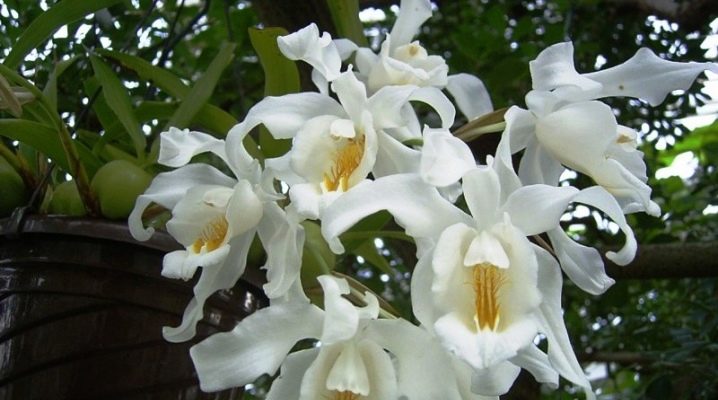
The graceful cellogin orchid stands out among other members of the orchid family for long flowering, as well as relative unpretentiousness and the ability to "forgive" the flaws of a novice gardener. In addition, a large number of emerging snow-white flowers that resemble openwork lace from afar are considered a plus of the variety.
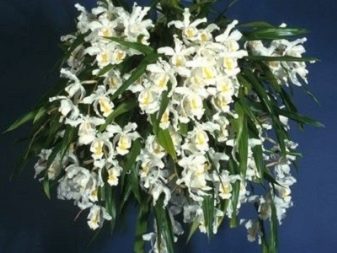
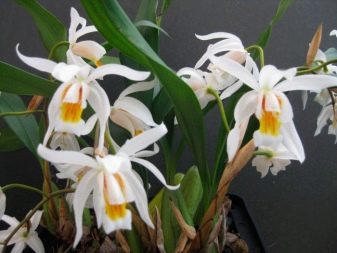
Peculiarities
The cellogyne orchid has several varieties, but all of them are characterized by a number of common characteristics. During sympodial development, formations are formed that have a smooth skin and an oval shape, reaching about 5 centimeters in length. At the top of each pseudobulb, a pair of green leaves grow, and below, peduncles with several pleasantly smelling buds. Each flower, in turn, has five petals and a wide, three-lobed lip. As they unfold, they grow to a diameter of 9 centimeters.
Orchid roots are rather short. The sheets of cellogyne sometimes reach a length of 30 centimeters. They have a beautifully defined fold, a rich green hue and an attractive gloss.

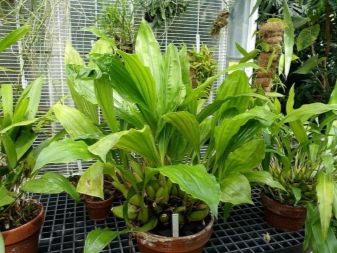
The flowers of most of the cellogin are painted in a sparkling snow-white color. Occasionally, cream and green-yellow patterns are also found. On the lip, peculiar yellow or orange outgrowths, called a ridge, are often formed. The aroma of such an orchid is pleasantly sweet and unobtrusive.
The plant blooms in the middle of winter, and the period of loose buds continues until the beginning of spring. Depending on the conditions of development, these dates may shift, for example, flowering will occur in March and will last until July.
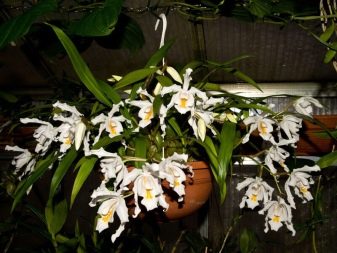
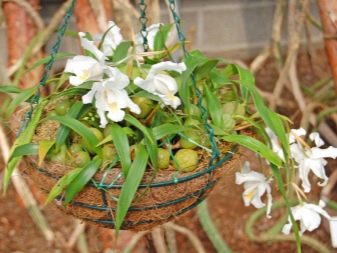
Popular types
For home cultivation, a fairly large number of varieties of this orchid are selected, and there are about a hundred of them in total. For example, it can be the varieties Pachistakhis, Usitana, Asperata, Suvada, Odoardi, Assamika, Gandiflora or Mura.
Kristata
Kristata, which is also called cellogyne gebench, grows naturally only in the Himalayas, practically in the snow. This explains the fact that this variety does well at low temperatures.
Cristata bloom during the usual period from mid-winter to early spring.
Pseudobulbs are formed in the form of an elongated ball, 3 to 5 centimeters long, and sometimes take the form of a tetrahedron with a pair of long leaves. On each peduncle, approximately 8 flowers appear, painted in a beautiful white color and reaching 10 centimeters in diameter. The lip is characterized by the presence of 3 lobes and 5 projections resembling scallops. The height of the crested cellogyne reaches an interval of 15 to 30 centimeters.
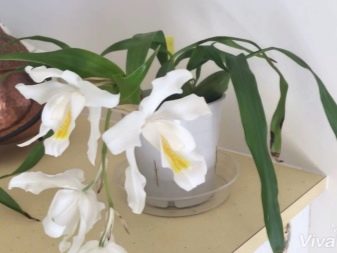
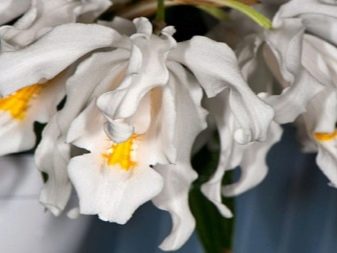
Massange
Celogin tomenta or massage is a rather capricious orchid. Her flowers appear smaller than ordinary ones, but pseudobulbs have a much larger diameter. Massange's leaves grow very long, up to 50 centimeters long, but narrow - the width is only 1 centimeter.
In contrast to the same cristata, the leaves are on petioles, and the roots are of considerable length. The buds appear creamy with brown outgrowths on the lip.
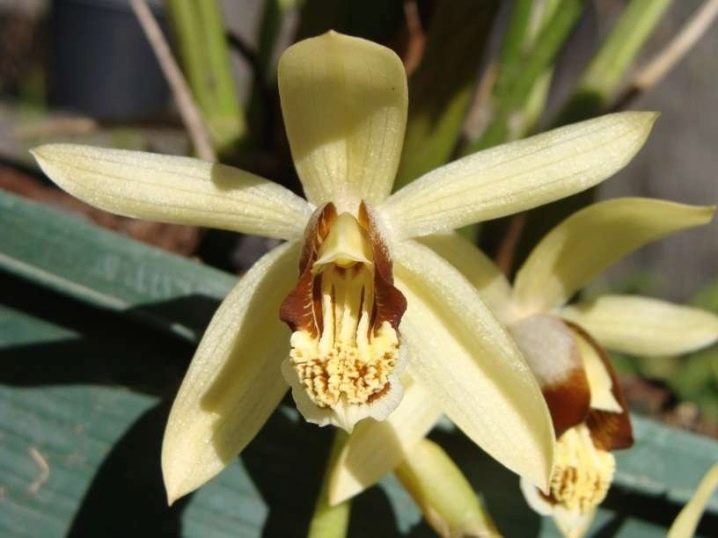
Flacida or drooping
Celogyne flacida or drooping is a rather compact flower that delights gardeners with deliciously smelling white flowers. The lip of the orchid is decorated with three outgrowths, as well as specks of yellow-orange color. On an elongated peduncle, usually 15 to 17 buds appear.
Bulbs, by the way, are also quite long and have a pair of bright glossy leaves.
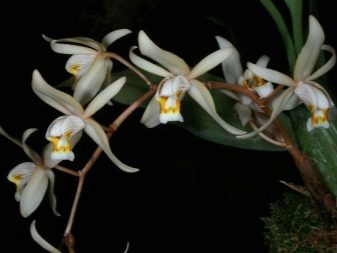
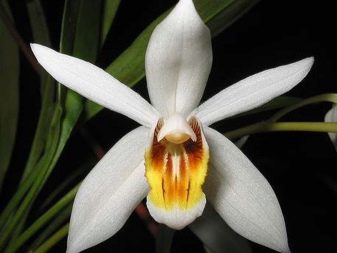
Pandurat
Tselogin pandurat is characterized by the presence of elongated pseudobulbs, the length of which ranges from 8 to 10 centimeters. The length of the leaves, belonging to the belt-like type, reaches 45 centimeters. The peduncle is covered with a dozen flowers, painted in a creamy green hue. The lip is decorated with specks of black and brown.
Pandurata is a thermophilic plant that blooms in the first months of summer.

Speciosa or beautiful
The orchid of cellogyne specosa can grow naturally both on trees and on rocks. Dense pseudobulbs, shaped like a testicle, are formed on a thickened rhizome. The length of the leaves ranges from 10 to 40 centimeters, and their end is a sharp tip.
From one to four flowers appear on the peduncle, blooming one after the other and reaching a diameter of ten centimeters.

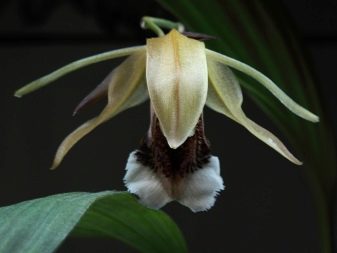
Rohussen
Rohussen's cellogyne is an epiphyte. In nature, it grows on islands, in conditions of high air humidity. During development, a large number of peduncles with beautiful flowers appear. The aroma of such an orchid resembles a citrus scent.
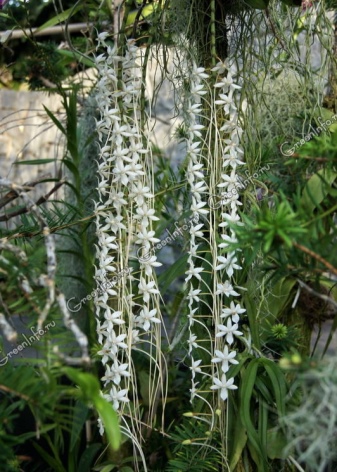
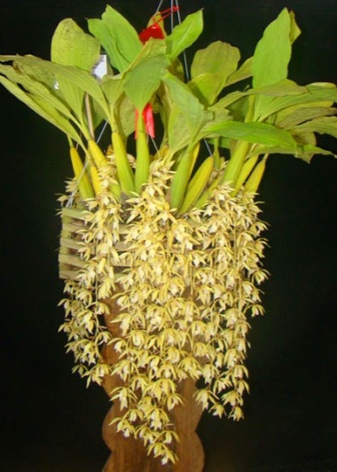
Ovalis
Celogyna ovalis grows in natural conditions epiphytically on trees. It is characterized by the appearance of yellow-green flowers with a lip covered with streaks of brown. The size of the opened bud reaches 3 centimeters. The length of the pseudobulb ranges from 3 to 6 centimeters, and their width is only 1.5 centimeters. The formations have a pair of leaves and a fusiform shape. The length of the rich green leaves is not too long - only 15 centimeters. The width of one formation ranges from 2.5 to 4 centimeters.
A twelve-centimeter peduncle grows on the top of the pseudobulb.

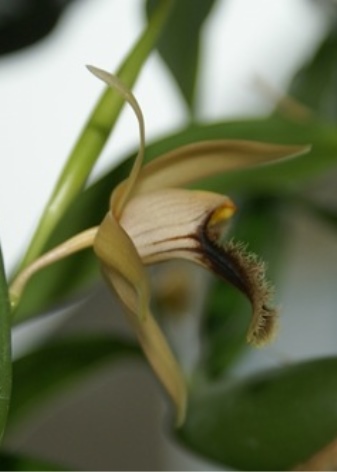
Tomentoza
Celogyne tomentosa is, in fact, the same cellogyne massange, the characteristics of which are described above.
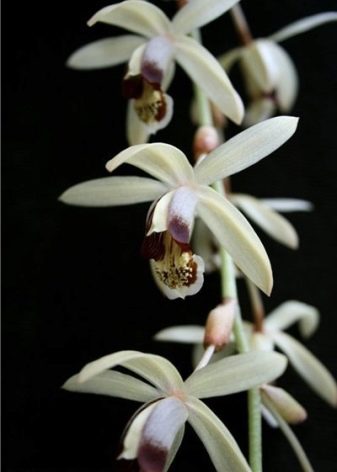
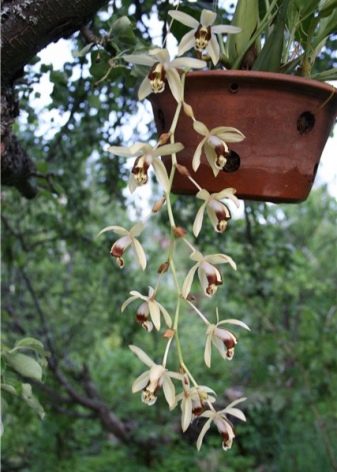
General rules for home care
The cellogyne orchid requires good lighting throughout the year. The optimal indicator is in the range from 4000 to 6000 lux - it can be achieved by placing the pots on the east or west window. If the orchid looks to the north, then it will need additional lighting, and if to the south, then protection from direct sunlight... The length of daylight hours should be observed for 12 or 14 hours, regardless of the time of the year. This suggests that in winter, additional illumination is still indispensable. Cellogines do well in greenhouses or flower display cases, but at home they should be placed either in the kitchen or in a bathroom equipped with a window. In addition, it is better to find a place higher - on a rack or shelf.
Different types of orchids prefer different temperatures. On average, during the warm months, this indicator does not go beyond the boundaries of 20 to 25 degrees Celsius. In winter, heat-loving flowers require a temperature of at least 10 degrees, and cold-loving ones - about 5 degrees.
The cycle of some cellogyne includes a period of rest, while for others it is absent. In the first case, during this period it is important to provide the flower with proper conditions, for example, to reduce the amount of water used for irrigation.
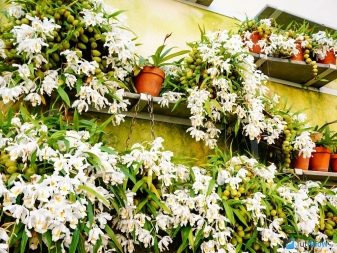
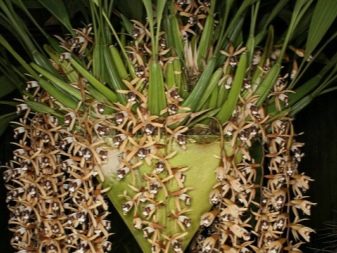
At this time, watering is carried out when the topsoil dries out, and in cool climates it is generally replaced by spraying. Irrigation should also decrease in autumn. The flower requires the most moisture while the roots grow and new pseudobulbs are formed. Generally, cellogyne does not tolerate complete drying out of the soil, especially while the orchid is growing... In the summer, you can determine the need for watering by the state of young pseudobulbs - if they are shriveled, then it is time for irrigation.
Ideally, it is recommended to irrigate the cellogin by immersing the pot in a container of water for a few minutes. The liquid used must be filtered or even boiled.
If you do not take this recommendation into account, then a salt deposit will appear on the soil surface, which, of course, will harm the plant. The temperature of the liquid should be set slightly higher than the air temperature so that the roots do not get overcooled. The humidity in the room should be high. To provide it in the mornings and evenings, it is recommended to spray the orchid with settled water. In addition, it will be useful to organize a pallet under the pot filled with expanded clay and filled with water.
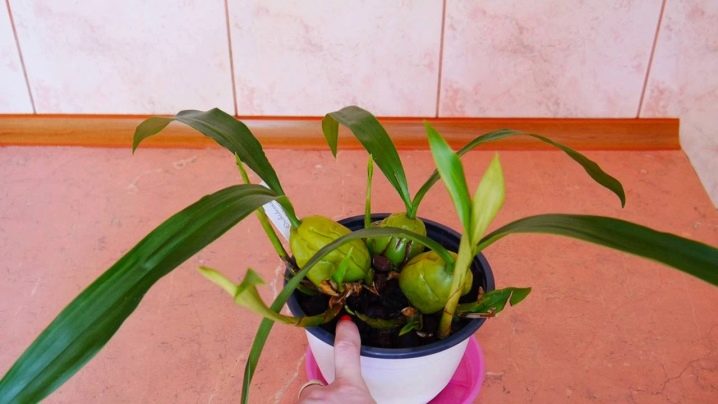
When planting, it is better to purchase a ready-made soil mixture for orchids. It is important that the soil is fine-grained and contains fragments of pine bark, 1 centimeter long, as well as decomposed leaf compost... If the celogyne has long roots, then it would be better to place the flower on pine bark blocks. Having fixed the rhizome by using a wire, then it must be covered with sphagnum. Care in this case is characterized by more frequent watering and spraying.
The transplant is carried out only when the size of the pot does not correspond to the size of the plant. During the procedure, it is recommended to place pebbles or several pieces of granite at the bottom of the pot, especially if a small bush can turn over. While the orchid is actively developing, fertilization should be applied every week.
When flowering already begins, fertilizing is reduced to once a month.
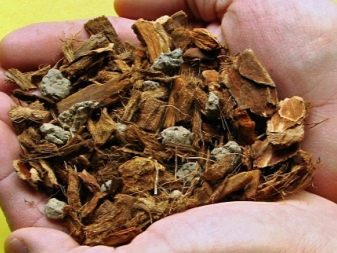
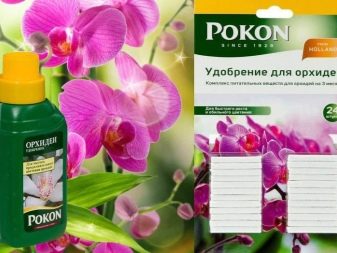
Reproduction methods
At home, the cellogin orchid is recommended to be propagated by division. An adult flower, which has formed several large pseudobulbs, is suitable for this purpose. When forming delenki, it is important to ensure that both young and mature formations, as well as a developed root system, are present on each... The separation is carried out in the spring, and not by hand, but with the help of a sharpened instrument with maximum accuracy.
Usually, each orchid is divided into two or three parts. During the process, it is worth leaving the ground on the roots, and also immediately treating root injuries with crushed coal. The seed propagation method is used only in industry, with special equipment.
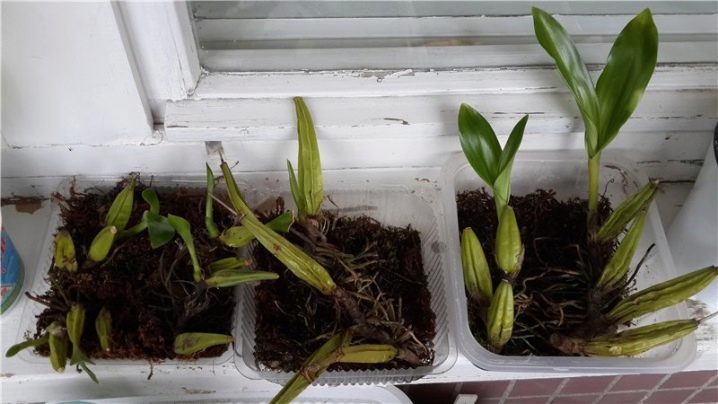
Diseases and pests
Most often, the cellogin orchid suffers from various fungal diseases, especially in the case of excessive watering. The treatment is carried out quite quickly and effectively with the use of suitable fungicides. The water should be soft and, ideally, filtered, because soil salinity leads to drying and death of the leaves. The most likely pest to settle on a flower is the spider mite, although aphid and whitefly attacks are also common. Having found a pest, the orchid must be washed with warm water and again treated with an insecticide. However, cellogin does not react in the best way to the use of chemicals, therefore, if possible, mechanical removal of insects and a change in care measures should be used.
Here are some tips for caring for your cellogin orchid.































The comment was sent successfully.